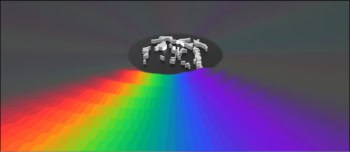A holographic acoustic tweezers (HAT) system has been used to suspend up to 25 objects in mid-air simultaneously. The feat was achieved by Bruce Drinkwater at the University of Bristol in the UK and Asier Marzo at the Public University of Navarra in Spain, who used a complex array of loudspeakers to create an intricate, controllable field of sound waves. The duo believes that their setup could have important medical applications in the near future, and could also be used to create physical 3D hologram displays.
Optical tweezers were invented in 1986 by Arthur Ashkin, who shared the 2018 Nobel Prize for showing that small dielectric objects including bacteria and viruses can be levitated and manipulated with a focussed beam of laser light. Since then, holographic optical tweezers (HOTs) have been developed to manipulate multiple objects and assemble 3D microstructures. However, HOTs have several shortcomings. Since light can only travel through transparent media, HOTs are unable to operate within more opaque media, including human tissues. Another problem is that the lasers used to create HOTs deliver a significant amount of energy, which can damage objects such as living cells.
In contrast, HATs allow for manipulations of objects within a wide variety of liquid and solid media. HATs operate with over 100,000 times greater power efficiency than HOTs, which means that far less energy is delivered to the objects – resulting in less damage to the objects being manipulated. Furthermore, HATs are able to manipulate larger objects (up to the centimetre scale) than HOTs.
Intricate sound field
Drinkwater and Marzo have built a HAT system that offers the benefits of a HOT, while using far less energy. Their system is directed by an algorithm that creates an intricate sound field by the precise control of the phases of 40 kHz sound waves emitted by an array of 256 small loudspeakers.

The wonderful world of ultrasound
They tested the setup, firstly by suspending up to 25 millimetre-sized polystyrene spheres in mid-air simultaneously. The researchers were also able to sew a length of thread into a piece of fabric, simply by attaching a polystyrene sphere to each end and precisely controlling their movements.
Drinkwater and Marzo are confident that HATs could soon be used to assemble objects on micron and millimetre scales. By creating yet more intricate fields of sound waves, their technology could be used to suspend large arrays of physical 3D pixels. This could be used to create tangible hologram displays in mid-air.
The duo will now work towards adapting their existing setup to manipulate objects within water; aiming to demonstrate the technology in around a year’s time. Soon after this demonstration, they hope that their methods will be adapted further, enabling the manipulation of objects within biological tissues, potentially allowing for intricate, non-invasive cell positioning and targeted drug delivery.
The HAT is described in Proceedings of the National Academy of Sciences.



